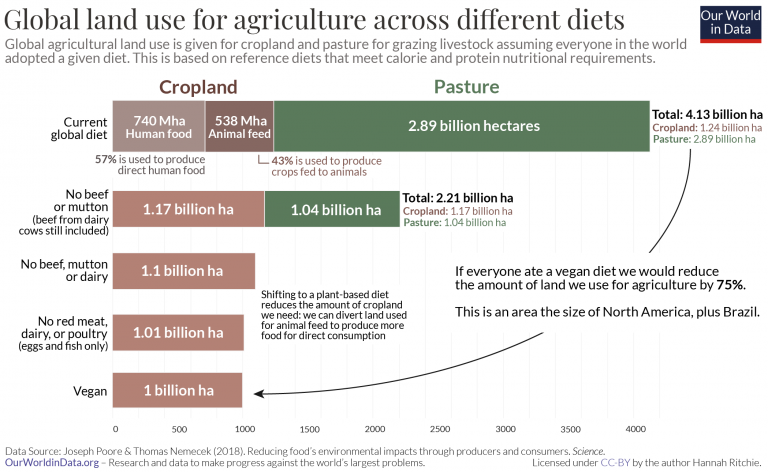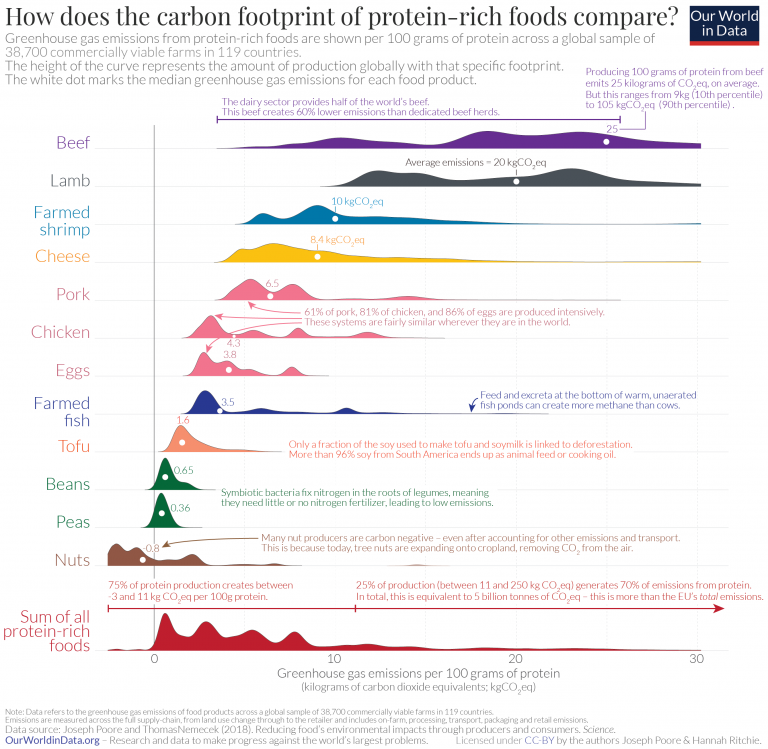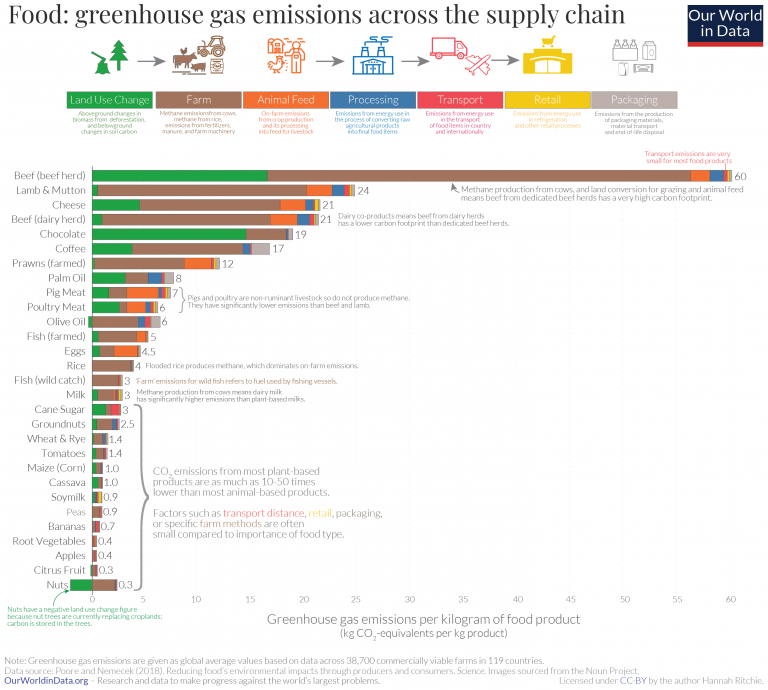Summary
The climate impact of diets are usually compared in terms of greenhouse gases that are emitted today. But this misses a hidden cost: the carbon opportunity costs of agricultural land. If we were not using this land to grow food, it would be possible that forests and wild grasslands grow on these lands. They would not only harbour wildlife, but also store much more carbon. Meat and dairy products need more land than alternatives, and therefore have a higher opportunity cost.
Going vegan would result in the largest carbon savings, but even just a reduction of meat and dairy consumption – without eliminating it completely – can also have a massive impact. In fact, a diet that replaces beef with chicken and cuts out dairy would achieve almost as much as a fully vegan diet.
Over the last 10,000 years agricultural land has expanded into forests, wild grasslands and other ecosystems. The world lost one-third of its forests, and today agricultural land makes up half of the world’s ice- and desert-free land.
The loss of these forests and other natural vegetation has released a lot of carbon into the atmosphere: we have emitted around 1400 billion tonnes of CO2 over millennia.1 That’s equal to 40 years’ worth of our current emissions from fossil fuels.2
It can be easy to forget about these emissions that happened decades, centuries, or even millennia ago. We tend to only focus on emissions today. This undersells the role that our agricultural land use could play in tackling climate change. In this article I’ll explain why this is the case.
To understand this we need to consider one of the key concepts in economics: opportunity costs. An opportunity cost is the potential benefit you’re giving up by choosing one option over the other. Every decision you make has an opportunity cost – you could be spending your time or money on something else. Spending time watching television comes at the ‘cost’ of not reading a book or not visiting a friend. Choosing pizza comes at the cost of not having pasta instead.
In the standard framework of counting greenhouse gas emissions, opportunity costs are not taken into account. The ‘carbon footprint’ figures usually reported for different foods are based on greenhouse gas emissions today: how much nitrous oxide is produced when we add fertilizers; methane released by cows; carbon released when we cut down forest and replace it with crops. Land use is not included unless it changed in the last year.
The opportunity costs of land are the possible alternative uses for this land. If we weren’t using it to grow crops or raise livestock, it could be restored to forest or wild grasslands. Restoring these could take at least some of the 1400 billion tonnes of CO2 back out of the atmosphere, and put it back into vegetation.
Storing this carbon in vegetation and soils is the opposite of emissions. It’s negative emissions. Since we need to urgently reduce the amount of CO2 in the atmosphere, minimising the amount of land the world needs to feed itself is a possible solution. Of course, CO2 in the atmosphere is not the only metric we care about: there is a complex range of socioeconomic factors (such as the livelihoods of people who work in the farming sector) to consider. What we’re doing here is presenting the scientific understanding of what happens to one of those elements – carbon – across a range of possible futures. It’s up to society to decide what it should do, given the choices available.
Here, we look at the impact our dietary choices could have when we factor in the opportunity costs. If the world gave up meat and dairy completely, how much carbon would we possibly save? Do we need to go vegan to make a big difference?
Vegan, vegetarian, flexitarian: how much carbon could different diets save?
Let’s first see how taking opportunity costs into account affect the comparisons of individual food items.
In the chart here we see the comparison of the carbon costs of different meat and dairy foods, and high-protein substitutes.3 In blue we see the emissions from food production – this is the metric that almost everyone uses to compare products. This tells us how much greenhouse gases have been emitted to produce the food over the full supply chain – from farm to supermarket. In green we see the opportunity costs: this is the amount of carbon that could be stored on the land if we would decide to abandon it and let natural vegetation regrow.
As we’d expect, because livestock such as cows and sheep need a lot of land, they have much higher opportunity costs. Producing one kilogram of beef can have total carbon costs at least ten times higher than protein-rich alternatives such as tofu or tempeh. In extreme cases, where beef and lamb are produced at low intensities – such as in Brazil – the opportunity costs of agricultural land are huge. Total carbon costs can be as much as 100 times higher than the alternatives.
What this also makes clear is that we can save a lot of carbon by making wiser choices about where to produce our food. Producing food where the yields are high reduces the amount of land we need for agriculture, giving us the opportunity to store carbon in forests and grasslands.
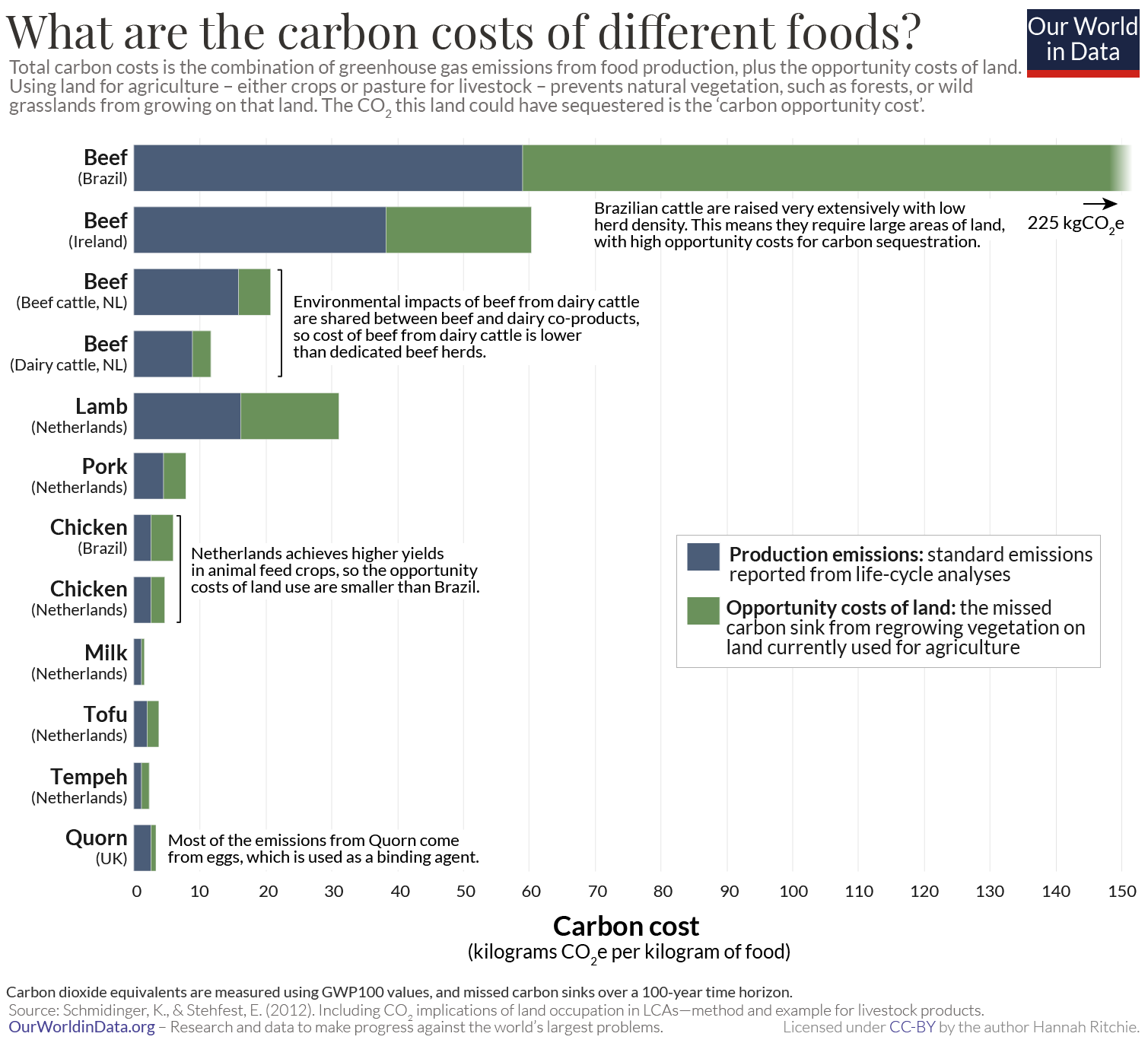
Of course, for proper nutrition and health we need to eat a diverse range of foods. So let’s see how different diets – rather than individual foods – compare.4 In the chart we see the potential carbon reductions that we could achieve through dietary changes across the world. This measures – in blue – the annual reduction in global greenhouse gas emissions from food if everyone in the world adopted a given diet. In green we see the amount of carbon that could additionally be sequestered in restored vegetation and soils.5 This sequestration in restored vegetation represents how much carbon is stored as forests, grasslands and other landscapes grow back. Obviously these plants won’t keep growing forever. Eventually regrowth will level off, but it will take many decades to get there. In the next section we will look at the maximum amount of carbon that could be stored once vegetation stops regrowing.
Our food system is currently responsible for 13.7 billion tonnes of carbon dioxide equivalents (GtCO2e) each year. That’s one-quarter (26%) of total greenhouse gas emissions.
If people decided to cut out beef and lamb, we would reduce emissions by 2.6 GtCO2e per year (a 20% reduction), and save an additional 4.5 GtCO2e by restoring vegetation on abandoned farmland. If we also cut out dairy we could save 12.3 GtCO2e each year – almost as much as global food emissions today.
What’s interesting is that most of the carbon reductions come from cutting out beef and dairy. This means eating chicken, pork, fish or plant-based substitutes is the most effective way to reduce the land use and carbon impact of your diet.
If everyone would decide to become vegan we would achieve the largest carbon reduction. We could halve annual emissions from food production. And, as we saw in a related article, switching to a vegan diet would reduce our agricultural land use by 75%. This means we could sequester an additional 8 billion tonnes of CO2 in vegetation and soils each year. Combined, this would reduce greenhouse gases by 14.7 billion tonnes of CO2e each year.
Thankfully there is no trade-off between production emissions and opportunity costs: what reduces emissions the most also results in the greatest reduction in opportunity costs. Shifting to a more plant-based diet achieves both.
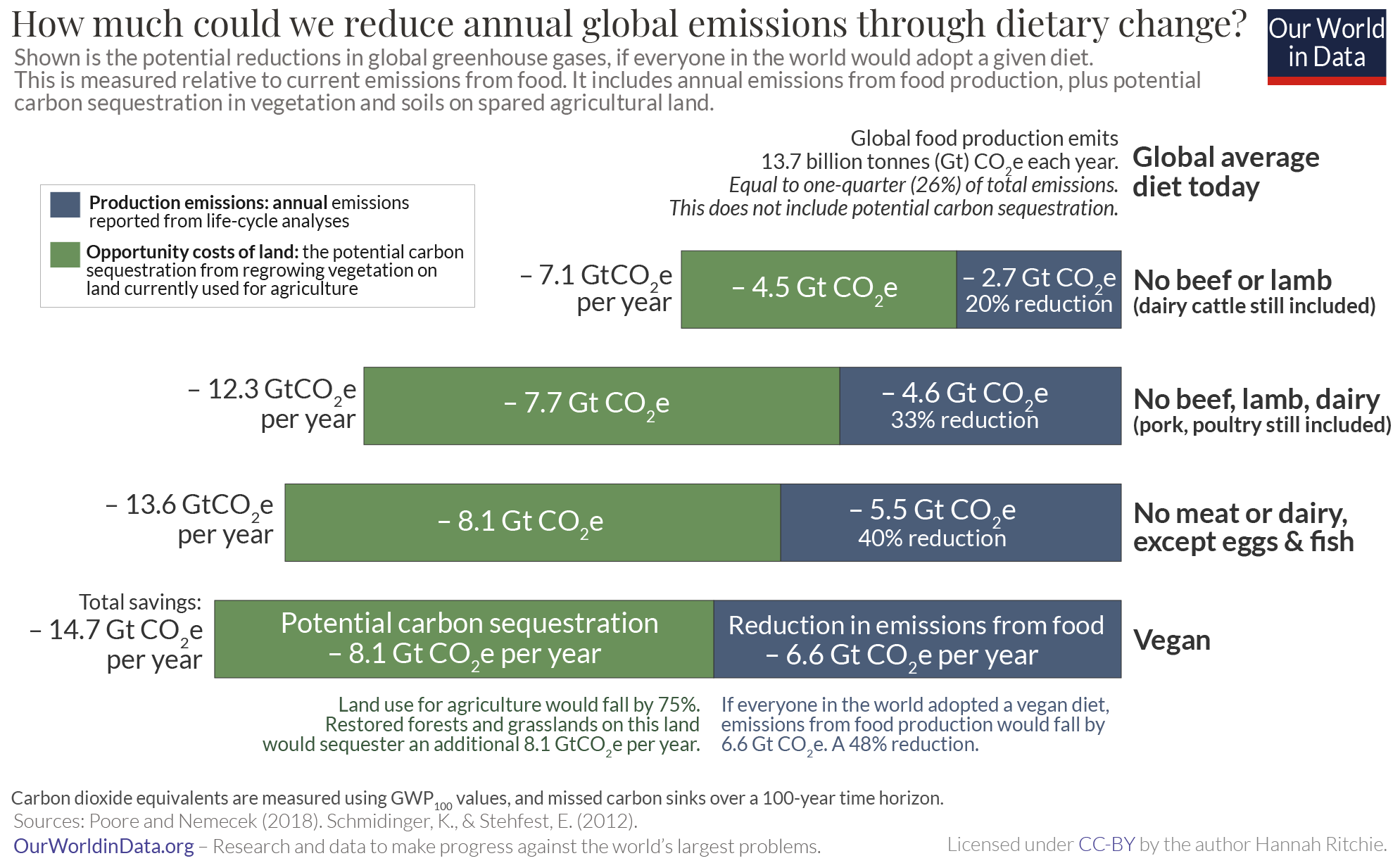
How much carbon dioxide could the regrowth of trees and wilderness store if we would reduce the consumption of meat and dairy?
So far we’ve looked at the potential carbon costs of individual diets. We’ve calculated this in terms of annual carbon reductions – the amount that’s absorbed as vegetation is regrowing. But there is a limit to how much carbon we can possibly store in the world’s vegetation. If we abandoned our farmland, forests, grasslands and other vegetation would regrow over the course of many decades. They’d be sequestering more and more carbon as they go. But eventually this growth will level off: they will continue to store carbon, but not sequester more and more.
To understand how much carbon the world could save, researchers Matthew Hayek, Helen Harwatt, William Ripple and Nathaniel Mueller estimated the cumulative carbon opportunity costs of global dietary change.6 They looked at the changes in carbon that could be sequestered if everyone in the world adopted a given diet today, under three scenarios.7 These are shown in the chart.
Business-as-usual: The change of global diets up until 2050 follows a similar trajectory to the past – meat and dairy consumption in lower- and middle-income countries rises as they get richer, just as it did in high-income countries.8 This scenario expects crop yields to increase, but not enough to keep up with demand and so we’d actually need more agricultural land than we have today. We’d emit additional carbon rather than saving it.
Vegan diet: In a hypothetical scenario in which everyone in the world went vegan by 2050, the regrowth of trees and wilderness could sequester around 547 billion tonnes of additional CO2. Each year we emit around 36 billion tonnes of CO2 from fossil fuels, so that’s equal to around 15 years of emissions at our current levels.9 They also estimate an additional 225 billion tonnes of CO2 could be stored in soils, although soil sequestration estimates are more uncertain.10
EAT-Lancet diet: This diet is one in which people decide to reduce meat and dairy consumption but doesn’t cut it out completely.11 Relative to the 2050 ‘business-as-usual’ diet, it reduces beef consumption by 80%; lamb by 70%; milk by 27%; pork by 87%; chicken by 49%; and eggs by 52%. This is a diet in which everyone would eat on average 47 grams of beef per week (equivalent to one burger); 19 grams of lamb; one to two rashers of bacon; a few portions of chicken; and one to two eggs. It also includes around 200 grams of dairy (milk, cheese, yoghurt and other dairy products) per day. A shift towards this more plant-based would save 332 billion tonnes of CO2 – equal to around 9 years’ worth of current fossil fuel emissions.12 They also estimate an additional 135 billion tonnes of CO2 could be stored in soils.
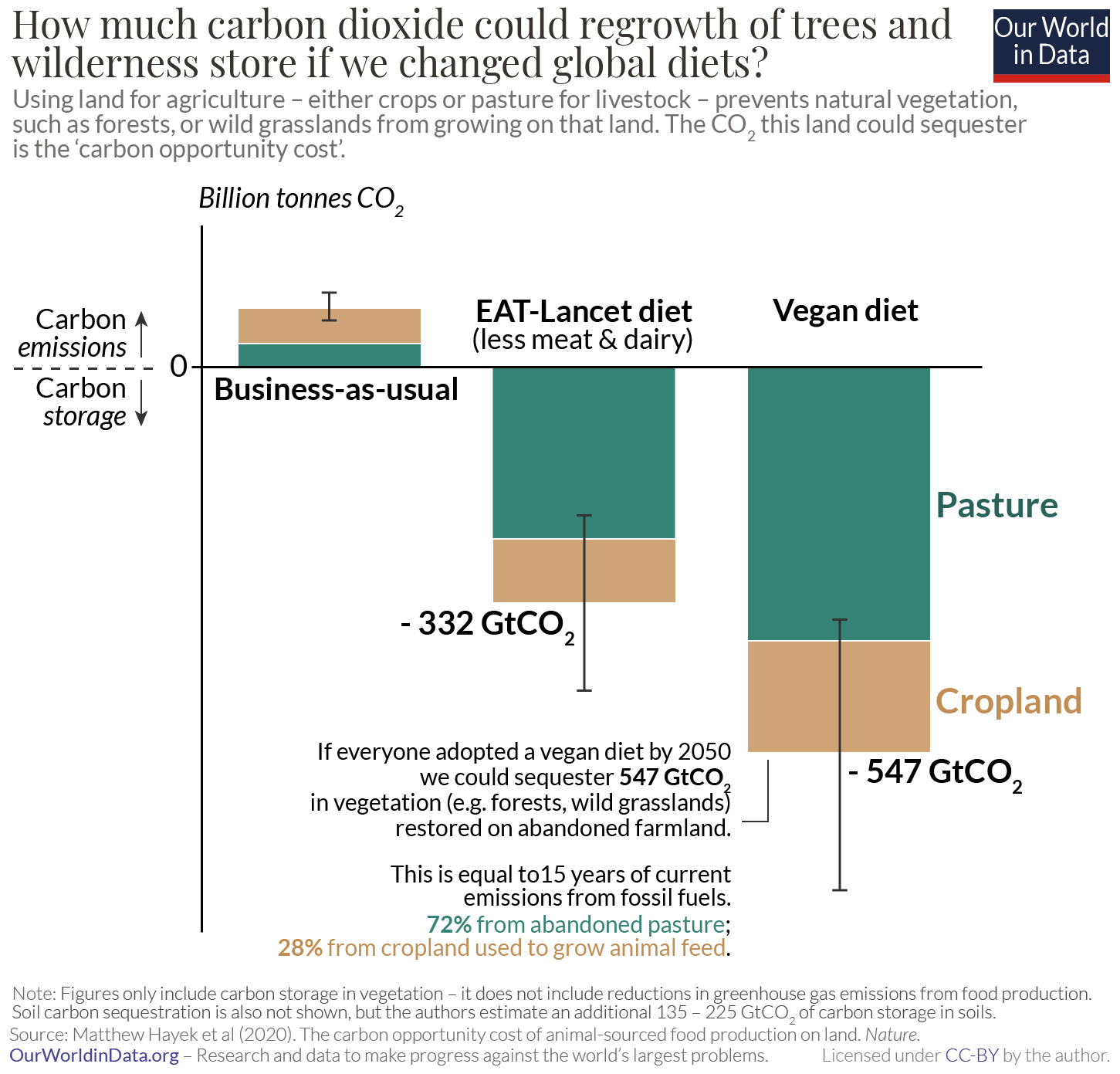
Dietary changes could double our carbon budget for 1.5°C – but it’s no substitute for getting off fossil fuels
How close could transforming the global food system in these ways take us to the UN climate targets?
Let’s put these numbers in the context of our global carbon budget. Our ‘carbon budget’ is an estimate of how much carbon we can emit from this point forward and still keep global temperature rise below a given threshold.13
In the chart we see the potential carbon sequestration from the vegan and EAT-Lancet diet compared to the median carbon budget for keeping temperature rise below 1.5℃ and 2℃.14 We see that if everyone adopted a vegan diet, by 2050 we could increase our carbon budget for 1.5℃ by 125%; we would more than double our budget. If we adopted a reduced meat diet, we’d still increase our budget by 75%.
These numbers are large – increasing our carbon budget even by 50% would make a massive difference. But it’s no substitute for getting off fossil fuels. The 547 billion tonnes CO2 we could sequester from a vegan diet is equal to 16 years of current fossil fuel emissions. If we don’t change how we produce our energy, all of this carbon sequestration would only mean that we are in the exact same position 16 years later.
Changing the way we eat will not solve climate change on its own, it would buy us more time to do so.
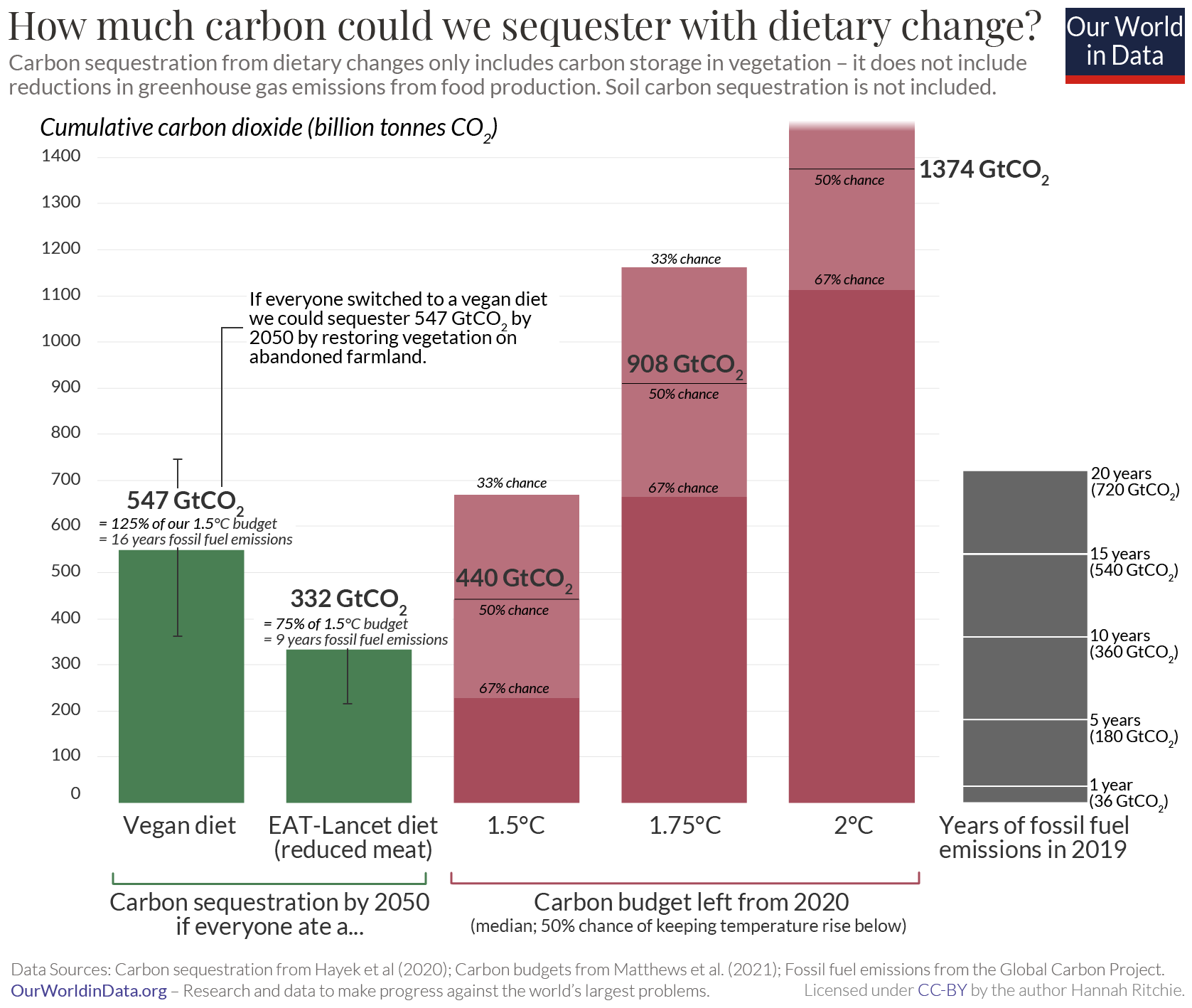
More of our articles on this topic…
